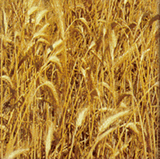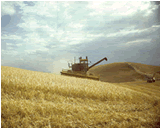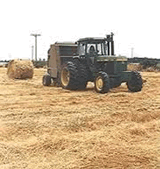Straw-to-Energy? It Might Be Worth A Try
By Ken D. Duft*
Issue, Action taken, Impact, Project
![]() Printable
document in pdf format.
Printable
document in pdf format.
Summary
 A Washington State University study has found that crop residue produced by Eastern Washington wheat, barley, and grass seed growers could fuel the generation of about 400-425 megawatts of electricity annually; more than that produced by any one of our current Snake River dams. While energy production from straw is more expensive than hydro and nuclear, blend pricing, environmental benefits, and the volatile electricity market make it attractive.
A Washington State University study has found that crop residue produced by Eastern Washington wheat, barley, and grass seed growers could fuel the generation of about 400-425 megawatts of electricity annually; more than that produced by any one of our current Snake River dams. While energy production from straw is more expensive than hydro and nuclear, blend pricing, environmental benefits, and the volatile electricity market make it attractive.
Issue
Eastern Washington growers produce abundant crops of wheat, barley, and grass seed. In doing so, they produce millions of tons of straw. Excess crop residue can serve to reduce yields, propagate crop pests, and pose an obstacle for planting the next crop. Disposal of excess crop residue, especially in the highest yielding counties, is a problem. Field burning, the historical and most economical solution, is no longer a socially acceptable.
 Photo: Wheat Stubble Burning Courtesy of Larry Schwarm used with his permission
Photo: Wheat Stubble Burning Courtesy of Larry Schwarm used with his permission
Over the past decade, power demand in Washington, Oregon, and Idaho has risen 24 percent while the region’s capacity to generate power has increased by only four percent, according to the Northwest Power Planning Council. Costs of buying energy when demand has exceeded supply have skyrocketed for utilities. And as a result, ratepayers have seen an escalation in electric bills. The energy crisis in California exacerbated already short supplies in the Northwest. Depending on the season, Washington and Oregon import and export power from California. The 2001 draught left the Northwest with low levels of snow pack to feed rivers and reservoirs for hydroelectric generation.
The technology for burning straw for power is not new. While no straw-burning electrical generating facilities exist in the United States, several European countries, including Denmark, the United Kingdom, and Spain, do have large, efficient plants, burning 2 million tons of straw per year.
What Has Been Done
 A Washington State University study attempted to determine how much straw is available, the total cost of getting straw from the field to point of incineration; the most cost-effective methods of doing that; the costs of building and operating a straw-power electrical co-generating plant, and the break-even pricing of electrical power produced.
A Washington State University study attempted to determine how much straw is available, the total cost of getting straw from the field to point of incineration; the most cost-effective methods of doing that; the costs of building and operating a straw-power electrical co-generating plant, and the break-even pricing of electrical power produced.
Impact
The study found that Eastern Washington grain growers produce about 3 million tons of straw that is economically feasible to harvest. That much straw has the potential for producing 400-425 megawatts of energy each year.
While the cost of electrical production – about 8.5 cents per kwh. – would be considerably higher than either hydro or nuclear sources, blend pricing, environmental benefits and the volatile energy market still make straw-to-energy worth considering.
 Blend pricing refers to how electricity suppliers price their products. Though power produced from straw may be uneconomical when priced at the margin, blended with lower-cost sources, such as hydro and nuclear, may make it economically feasible, especially when energy supplies from lower-cost sources are limited and in short supply. The recent volatility of the energy market may provide additional incentive.
Blend pricing refers to how electricity suppliers price their products. Though power produced from straw may be uneconomical when priced at the margin, blended with lower-cost sources, such as hydro and nuclear, may make it economically feasible, especially when energy supplies from lower-cost sources are limited and in short supply. The recent volatility of the energy market may provide additional incentive.
Straw is attractive as a fuel because it is renewable and considered to be carbon dioxide neutral. CO2 released into the atmosphere when burned for energy is offset by the amount of carbon dioxide absorbed by the biomass source from the atmosphere when it is growing.
Researchers concluded that cooperatives might provide the appropriate organizational form of business needed to initiate this straw-to-energy conversion. As such, those producing the straw would not only benefit from the disposal of this by-product, but would stand to benefit from the sale of the straw and the management/ownership of the resultant off-farm enterprise.
AREA OF IMPACT: Extension
Funding
- Bonneville Power Administration
- WA State Council of Farmer Cooperatives
- Northwest Cooperative Development Center
- State of Washington
Location of Impact |
Adams | Douglas | Lincoln |
| Asotin | Franklin | Spokane | |
| Benton | Garfield | Walla Walla | |
| Columbia | Grant | Whitman |
*Ken Duft is an Extension Economist emeritus at Washington State University, (509) 335-2972.
Secondary content using h2 tag.
Lorem ipsum dolor sit amet, consectetur adipisicing elit, sed do eiusmod tempor incididunt ut labore et dolore magna aliqua. Ut enim ad minim veniam, quis nostrud exercitation ullamco laboris nisi ut aliquip ex ea commodo consequat. Duis aute irure dolor in reprehenderit in voluptate velit esse cillum dolore eu fugiat nulla pariatur. Excepteur sint occaecat cupidatat non proident, sunt in culpa qui officia deserunt mollit anim id est laborum.
Heading using the h3 tag
Lorem ipsum dolor sit amet, consectetur adipisicing elit, sed do eiusmod tempor incididunt ut labore et dolore magna aliqua. Ut enim ad minim veniam, quis nostrud exercitation ullamco laboris nisi ut aliquip ex ea commodo consequat. Duis aute irure dolor in reprehenderit in voluptate velit esse cillum dolore eu fugiat nulla pariatur. Excepteur sint occaecat cupidatat non proident, sunt in culpa qui officia deserunt mollit anim id est laborum.